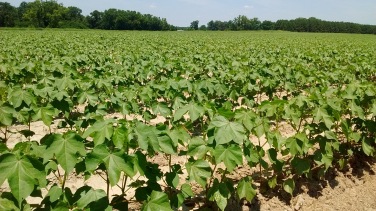Your cart is currently empty!
A gentle plea for field crops in the garden

Wheat in the annual border? Cotton blooming amongst the zinnias? Rice in the rain garden? Is that crazy talk? Field crop plants seem out of place in the home garden, but could it be we’ve undervalued them? I think we have, and we would all benefit from an occasional foray into growing them. I’m not arguing for everyone to pull out their roses and put in a patch of soybeans, nor am I advocating for everyone to turn survivalist and attempt to grow a year’s supply of grain. However, I have been growing small patches of grain and fiber crops in my garden for almost a decade now, and have found the exercise to have a multitude of benefits.
Teach your family where their food comes from
I never considered planting field crop plants in my garden until a fateful train ride with my son. First, a bit of back story: My father was an agricultural researcher, and considered identifying major crop plants in any life-stage to be an Important Life Skill. On any given trip through the countryside, we would have conversations like this:
Dad: What’s growing in that field?
Teenage me: Er…I don’t know…corn?
Dad: No, sorgum. You can tell because…(and here he launches into a few minute lecture on the agronomy and uses of sorgum)
Teenage me: Umm…ok. Why does this matter?
Dad: This is important! THIS IS WHERE YOUR FOOD COMES FROM!
Teenage me: Whatever, Dad.
I didn’t realize how unique a skill he had given me until years later. Fast forward a decade, and I am sitting with my, much less jaded, 2-year old son on a train.
Me: Look at the wheat growing in that field!
Son: Wheat!
Guy behind me: Oh, is that what wheat looks like? Hey, kids, look at the wheat!
Me (thinking to myself): Wait?!? This is the crop that made western civilization possible! How can a grown adult not know what it looks like? Has the general populace become so disconnected from farming that they don’t know what staple crops look like? I guess they have. Wait, I shouldn’t be so smug. Do I know how to grow any of these plants? I don’t! I’m a gardener; I should know. THIS IS WHERE OUR FOOD COMES FROM!
And from that moment on, I vowed to grow a small patch of a different grain or fiber crop in my garden each year to both teach myself and my progeny more about the crops’ life cycle and biology. You can do this too!
Test yourself, can you identify the plants in the picture below? Do you know how to grow them? If so, congratulations! You get bragging rights over most of your modern brethren. If not, consider planting a tiny patch yourself. If you have kids, or are a teacher, the little ones discovering where their food (and fiber) come from can be especially eye opening.
Become better connected to history
For much of recorded history, growing grain and fiber crops was what the majority of people spent the majority of their time doing. In fact, recorded history is arguably the direct result of the domestication of these plants. By growing them yourself, you will be quite literally be grounding yourself in a part of this history. Want a taste of life in ancient Mesopotamia? Grow emmer. Studying the Incas? Plant some quinoa. Want to learn about the Ethiopian empire? Try your hand at teff. Threshing and winnowing your own grains, while fun on a small scale, can also made make you appreciate the invention of the combine and other modern farm equipment.
Understand literature more deeply
From Little House on the Prairie, to the Little Red Hen, to the ancient sacred texts of the world’s major religions, staple crops are constantly referenced throughout literature. These stories will become much more vivid, and the references much more clear once you’ve tried your hand at growing these plants yourself.
Get crafty
Seed heads of wheat, broom sorghum, teff, and rice look great in fresh or dried flower arrangements. Cotton bolls give a southern charm to wreaths, and can be used to make a variety of Christmas decorations. Die-hard fiber nerds might enjoy trying their hand at growing their own cotton or flax for spinning (and simultaneously develop a firm appreciation for the invention of the cotton gin and modern retting processes).
Fill in “garden gaps”
Once I know how to grow a certain plant, this is usually my go-to reason for planting it again. Many agronomic plants make excellent, inexpensive place-holders. Warm-season grains like millet and broom sorghum can be used in landscape designs like other ornamental grasses. Pop a few patches of them in the back of the border to give quick vertical accents in the garden, or use them to foil the view of your neighbor’s shed while you wait for slower-growing perennials to fill in. Other plants can be used as “mini-cover crops” to suppress weeds in an attractive manner until you get around to planting something more permanent in an area. Wheat and rye work well for this in the fall and over winter. Buckwheat is an excellent temporary filler to plant during the spring and summer and, if allowed to bloom, is attractive to many pollinators and other beneficial insects to boot.
From educational value to practical uses, field crops have a place in any home garden. They connect us to history and literature, fill gaps in our over-ambitious garden projects, give us fodder for crafting, and yes, remind us of where our food comes from.
https://biologistsgarden.net/2017/07/16/a-gentle-plea-for-field-crops-in-the-garden/
On – 16 Jul, 2017 By biologistgardener





Leave a Reply